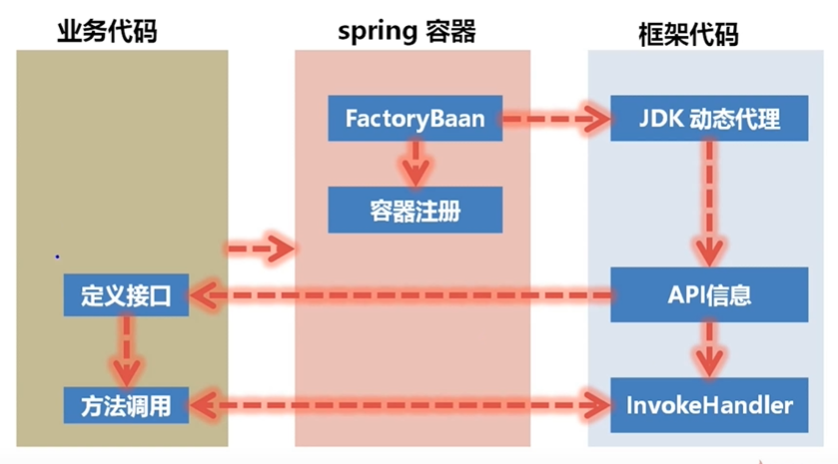设计思路

模拟一个类似 Feign 客户端
编写 IUser 接口
@Component@ApiServer("http://localhost:8080/user")public interface IUserApi {@GetMapping("/all")Flux<User> getAll();@GetMapping("/get/{id}")Mono<User> getById(@PathVariable("id") String id);@DeleteMapping("/delete/{id}")Mono<Void> deleteById(@PathVariable("id") String id);@PostMapping("/create")Mono<User> create(@RequestBody Mono<User> user);}
这里我们使用了一个自定义注解 @ApiServer 用来保存 URL 前缀
@Target(ElementType.TYPE)@Retention(RetentionPolicy.RUNTIME)public @interface ApiServer {String value() default "";}
对应的,还使用了一个 Domain User,用来接收和输入
@Data@NoArgsConstructor@AllArgsConstructor@Builderpublic class User {private String id;private String name;private int age;}
编写 Proxy 接口
调用接口 IUserApi 我们编写完成后,我们就需要对 IUserApi 进行代理,获取方法的参数,返回值等,并进行调用,由于代理可能会使用 JDK 动态代理,也可能使用 CGLIB 代理,所以我们先编写 Proxy 接口,接口很简单,只有一个方法,就是创建代理对象
public interface ProxyCreator {Object create(Class<?> clazz);}
需要使用到的两个 POJO
ServerInfo
ServerInfo,用来记录服务器信息,目前只记录服务器前缀,配合 @ApiServer 使用
@Data@Builder@NoArgsConstructor@AllArgsConstructorpublic class MethodInfo {/** 请求 URL */private String url;/** 请求方法 */private HttpMethod method;/** 请求参数 */private Map<String, Object> params;/** 请求体 */private Mono<?> body;/** 请求体的类型 */private Class<?> bodyElementType;/** 判断是 Flux 还是 Mono */private boolean returnFlux;/** 返回对象的类型 */private Class<?> returnElementType;}
MethodInfo
MethodInfo,用来描述方法信息,正对 IUserApi 接口中的方法
@Data@Builder@NoArgsConstructor@AllArgsConstructorpublic class MethodInfo {/** 请求 URL */private String url;/** 请求方法 */private HttpMethod method;/** 请求参数 */private Map<String, Object> params;/** 请求体 */private Mono<?> body;/** 请求体的类型 */private Class<?> bodyElementType;/** 判断是 Flux 还是 Mono */private boolean returnFlux;/** 返回对象的类型 */private Class<?> returnElementType;}
编写 RestHandler 请求接口
Rest 请求可以由 WebClient 来实现,也可以有 Spring 的 RestTemplate 来实现,所以为了更好的扩展,我们也抽象成接口的形式
public interface RestHandler {/*** 初始化服务器信息** @param serverInfo 服务器信息*/void init(ServerInfo serverInfo);/*** 调用 REST 请求** @param methodInfo 方法信息* @return Object*/Object invoke(MethodInfo methodInfo);}
编写 RestHandler 实现类(WebClientRestHandler)
这里我们使用 WebClient 来实现 RestHandler 接口
public class WebClientRestHandler implements RestHandler {private WebClient webClient;@Overridepublic void init(ServerInfo serverInfo) {webClient = WebClient.create(serverInfo.getUrl());}/*** 处理 Rest 请求** @param methodInfo 方法信息*/@Overridepublic Object invoke(MethodInfo methodInfo) {Object result;WebClient.RequestBodySpec bodySpec = this.webClient// 请求方法.method(methodInfo.getMethod())// 请求 URI.uri(methodInfo.getUrl(), methodInfo.getParams())// 响应格式.accept(MediaType.APPLICATION_JSON);// 判断是否含有 bodyif (methodInfo.getBody() != null) {bodySpec.body(methodInfo.getBody(), methodInfo.getBodyElementType());}// 发送请求WebClient.ResponseSpec request = bodySpec.retrieve();// 异常处理request.onStatus(httpStatus -> httpStatus.value() == 404, response -> Mono.just(new RuntimeException("Not Found")));// 处理响应if (methodInfo.isReturnFlux()) {result = request.bodyToFlux(methodInfo.getReturnElementType());} else {result = request.bodyToMono(methodInfo.getReturnElementType());}return result;}}
编写 Proxy 实现类(JDKProxyCreator)
这里我们使用 JDK 动态代理来实现
@Slf4jpublic class JDKProxyCreator implements ProxyCreator {@Overridepublic Object create(Class<?> clazz) {log.info("createProxy: {}", clazz);// 得到接口的 API 服务器地址ServerInfo serverInfo = extractServerInfo(clazz);log.info("serverInfo: {}", serverInfo);// 给每一个代理类一个实现RestHandler restHandler = new WebClientRestHandler();// 初始化服务器信息和 WebClientrestHandler.init(serverInfo);return Proxy.newProxyInstance(this.getClass().getClassLoader(), new Class<?>[]{clazz}, (proxy, method, args) -> {// 根据方法和参数得到调用信息MethodInfo methodInfo = extractMethodInfo(method, args);log.info("methodInfo: {}", methodInfo);// 调用 RESTreturn restHandler.invoke(methodInfo);});}private ServerInfo extractServerInfo(Class<?> clazz) {ApiServer apiServer = clazz.getAnnotation(ApiServer.class);ServerInfo serverInfo = new ServerInfo();serverInfo.setUrl(apiServer.value());return serverInfo;}private MethodInfo extractMethodInfo(Method method, Object[] args) {MethodInfo methodInfo = new MethodInfo();Annotation[] annotations = method.getAnnotations();// 1、获取请求方法和请求URLextractRequestUrl(annotations, methodInfo);// 2、获取请求参数extractRequestParam(method, args, methodInfo);// 3、获取返回对象信息extractResponseInfo(method, methodInfo);return methodInfo;}/*** 获取返回对象信息** @param method method* @param methodInfo methodInfo*/private void extractResponseInfo(Method method, MethodInfo methodInfo) {// 返回 flux 还是 mono// isAssignableFrom 判断类型是否是某个类的子类// instanceof 判断实例是否是某个类的子类// getReturnType 不带泛型信息boolean isFlux = method.getReturnType().isAssignableFrom(Flux.class);methodInfo.setReturnFlux(isFlux);// getGenericReturnType 带泛型信息Type actualType = getActualType(method.getGenericReturnType());methodInfo.setReturnElementType((Class<?>) actualType);}/*** 获取请求方法和请求URL** @param method method* @param args 参数* @param methodInfo methodInfo*/private void extractRequestParam(Method method, Object[] args, MethodInfo methodInfo) {Map<String, Object> params = new LinkedHashMap<>();methodInfo.setParams(params);Parameter[] parameters = method.getParameters();for (int i = 0; i < parameters.length; i++) {PathVariable pathVariable = parameters[i].getAnnotation(PathVariable.class);if (pathVariable != null) {params.put(pathVariable.value(), args[i]);}RequestBody requestBody = parameters[i].getAnnotation(RequestBody.class);if (requestBody != null) {methodInfo.setBody((Mono<?>) args[i]);Type actualTypeArgument = getActualType(parameters[i].getParameterizedType());methodInfo.setBodyElementType((Class<?>) actualTypeArgument);}}}/*** 获取参数实际类型** @param type 类型*/private Type getActualType(Type type) {ParameterizedType parameterizedType = (ParameterizedType) type;return parameterizedType.getActualTypeArguments()[0];}/*** 获取请求参数** @param annotations annotations* @param methodInfo methodInfo*/private void extractRequestUrl(Annotation[] annotations, MethodInfo methodInfo) {for (Annotation annotation : annotations) {// GETif (annotation instanceof GetMapping) {GetMapping mapping = (GetMapping) annotation;methodInfo.setUrl(mapping.value()[0]);methodInfo.setMethod(HttpMethod.GET);}// POSTelse if (annotation instanceof PostMapping) {PostMapping mapping = (PostMapping) annotation;methodInfo.setUrl(mapping.value()[0]);methodInfo.setMethod(HttpMethod.POST);}// PUTelse if (annotation instanceof PutMapping) {PutMapping mapping = (PutMapping) annotation;methodInfo.setUrl(mapping.value()[0]);methodInfo.setMethod(HttpMethod.PUT);}// DELETEelse if (annotation instanceof DeleteMapping) {DeleteMapping mapping = (DeleteMapping) annotation;methodInfo.setUrl(mapping.value()[0]);methodInfo.setMethod(HttpMethod.DELETE);}}}}
至此,我们就完成了 IUserApi 的动态代理
让 Spring 容器管理 IUserApi 和 ProxyCreator
我们使用 FactoryBean 来产生 IUserApi 对应的代理 bean
@BeanProxyCreator jdkProxyCreator() {return new JDKProxyCreator();}@BeanFactoryBean<IUserApi> userApi(ProxyCreator proxyCreator) {return new FactoryBean<IUserApi>() {/*** 返回代理对象*/@Overridepublic IUserApi getObject() throws Exception {return (IUserApi) proxyCreator.create(getObjectType());}/*** 返回接口类型*/@Overridepublic Class<?> getObjectType() {return IUserApi.class;}};}
测试
现在所需要的 ProxyCreator 和 RestHandler 都准备好了,我们就可以开始测试了
@RestControllerpublic class TestController {@Autowiredprivate IUserApi userApi;@GetMapping("/")public Flux<User> getAll() {// 实现调用 rest 接口的效果return userApi.getAll();}@GetMapping("/get/{id}")public Mono<User> getById(@PathVariable("id") String id) {Mono<User> mono = userApi.getById(id);mono.subscribe(System.out::println, e -> System.err.println(e.getMessage()));return mono;}@DeleteMapping("/delete/{id}")public Mono<Void> deleteById(@PathVariable("id") String id) {return userApi.deleteById(id);}@PostMapping("/create")public Mono<User> create(@RequestBody User user) {return userApi.create(Mono.just(user));}}

